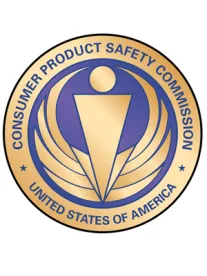On October 27, 2017, the U.S. Consumer Product Safety Commission (CPSC) issued a final rule prohibiting children’s toys and child care articles that contain specified phthalates. The rule caps off almost a decade of effort since Congress passed the Consumer Product Safety Improvement Act (CPSIA) in 2008, which requires regulatory action on certain phthalates. Under the final rule, children’s toys and child care articles that contain concentrations of more than 0.1 percent of diisononyl phthalate (DINP), diisobutyl phthalate (DIBP), di-n-pentyl phthalate (DPENP), di-n-hexyl phthalate (DHEXP), and dicyclohexyl phthalate (DCHP) are prohibited. The final rule removes the interim prohibition on diisodecyl phthalate (DIDP) and di-n-octyl phthalate (DNOP). The rule will become effective on April 25, 2018.
Background
CPSIA Section 108 established permanent and interim prohibitions on the sale of certain consumer products containing specific phthalates. It banned di(2-ethylhexyl) phthalate (DEHP), dibutyl phthalate (DBP), and butyl benzyl phthalate (BBP) in any amount greater than 0.1 percent in: (1) children’s toys; and (2) any child care article that is designed or intended by the manufacturer to facilitate sleep or the feeding of children age three and younger, or to help children age three and younger with sucking or teething. The Act also banned, on an interim basis, three additional phthalates: DINP, DIDP, and DNOP in any amount greater than 0.1 percent in: (1) any children’s toy that can be placed in a child’s mouth; and (2) any child care article that is designed or intended by the manufacturer to facilitate sleep or the feeding of children age three and younger, or to help children age three and younger with sucking or teething.
CPSIA Section 108 also directed CPSC to convene a Chronic Hazard Advisory Panel (CHAP) to study the effects on children’s health of all phthalates and phthalate alternatives as used in children’s toys and child care articles; and to provide recommendations to CPSC regarding whether any phthalates or phthalate alternatives, other than those already permanently prohibited, should be prohibited. CPSIA requires CPSC to promulgate a final rule after receiving the final CHAP report. The rule fulfills that requirement.
Final Rule
CPSC states that it considered the CHAP report, CPSC staff analyses, and comments submitted on its December 2014 proposed rule, as well as staff reports concerning later National Health and Nutrition Examination Survey (NHANES) data cycles. The briefing package prepared by CPSC staff provides the staff analysis of these materials and gives the staff recommendations for the final rule. The briefing package stated that CPSC issued the final rule based on consideration of these materials, and that the final rule “is substantially the same as the proposed rule.”
In the interest of clarity, the final rule restates CPSIA’s permanent prohibition on the manufacture for sale, offer for sale, distribution in commerce, or importation into the U.S. of any children’s toys and child care articles that contain concentrations of more than 0.1 percent of DEHP, DIBP, or BBP. The final rule continues the interim prohibition concerning DINP and expands the prohibition to all children’s toys (not just those that can be place in a child’s mouth) and child care articles that contain concentrations of more than 0.1 percent of DINP. According to the final rule, after reviewing the information presented by the CHAP, CPSC staff, and commenters, CPSC concludes “that continuing the interim prohibition regarding DINP will ensure a reasonable certainty of no harm to children, pregnant women, or other susceptible individuals with an adequate margin of safety.” CPSC “also determines that expanding the prohibition regarding DINP to cover all children’s toys, not just those that can be placed in a child’s mouth, is necessary to protect the health of children.” The final rule also prohibits children’s toys and child care articles that contain concentrations of more than 0.1 percent of DIBP, DPENP, DHEXP, and DCHP. After reviewing the information presented by the CHAP, CPSC staff, and commenters, CPSC “concludes that this restriction on the four additional phthalates is necessary to protect the health of children.”
The final rule removes the interim prohibition on DNOP and DIDP. CPSC states that based on the CHAP report and the staff’s analysis, it concludes that continuing the prohibition of children’s toys that can be placed in a child’s mouth and child care articles containing more than 0.1 percent of DNOP or DIDP “is not necessary to ensure a reasonable certainty of no harm to children, pregnant women, or other susceptible individuals with an adequate margin of safety.”
The final rule will take effect on April 25, 2018. It will apply to products manufactured or imported on or after that date.
Commentary
With the final rule, eight phthalates are now restricted from use in children’s toys and child care articles at concentrations of more than 0.1 percent. The final rule includes a paragraph repeating the statutory provision stating that the phthalates prohibitions apply to plasticized component parts of children’s toys and child care articles, or other component parts of those products that are made of materials that may contain phthalates. CPSC notes that this addition does not make any substantive change “but it provides clarity by placing this statutory language in the regulation.”
CPSC notes on its website that manufacturers are still responsible for ensuring that children's products are not considered “hazardous” under the general requirements of the Federal Hazardous Substances Act (FHSA). CPSC states: “It is the manufacturer's obligation to ensure that any alternative plasticizer that is used be adequately tested such that the manufacturer is confident it does not pose a risk of injury under normal use or reasonably foreseeable misuse.” Children’s products that are hazardous or contain a hazardous substance are automatically banned. CPSC notes that it has issued chronic hazard guidelines to assist manufacturers in complying with FHSA requirements. As of this writing, it is unclear if the rule will be subject to judicial challenge.


 />i
/>i
